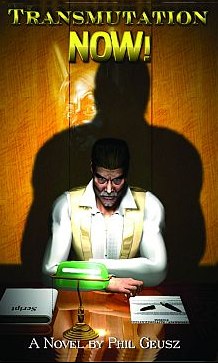Author: Phil Geusz
Publisher: Legion Publishing
ISBN10: none
ISBN13: 978-0-9771867-6-1
This s-f novel was first written during 1997-1998. It was almost immediately outdated by real-world technological advances. Nevertheless, it has had several new editions including this latest (2012) by Legion Publishing, proving that technological obsolescence cannot keep a good s-f story down. (How many futuristic thrillers about the Americans vs. the Soviets vying for world domination were rendered obsolete by the demise of the Soviet Union in 1991? Yet the best of them are still suspenseful political thrillers.)
In the undated but near future, biotechnological advances in decoding the human genome and DNA manipulation plus genetic splicing have enabled the human body to be turned into, well, almost anything organic; although the horrendously expensive cost limits this to a mostly theoretical breakthrough. The movie studio that aging star actor Jack Strafford is contracting to is willing to pay that price for the publicity value of converting Strafford into a genuine humanoid White Rabbit to play that role in a big-budget remake of Alice in Wonderland. Strafford’s initial refusal is turned to agreement by the studio’s promise to not only restore his human body after the shoot, but to recreate his younger, mid-20s body instead of his aging one. The transmutation process takes months in an artificial womb, and when Strafford wakes up, he is not a human-rabbit hybrid but an almost total rabbit, with human intelligence but a rabbit’s instincts. During his transmutation there was a terrorist nuclear bombing of Tokyo, a worldwide panic and major depression, and his movie studio went bankrupt before finishing paying for his extreme makeover. The medical technicians at Trans-Tech Genetics did all that they could for him with their own money, but Strafford is still left a small freak hopping about in a human world.
In the first part of the novel, Strafford and a similarly-modified chimpanzee-man (a scientist who was modified to study chimps in the wild, and was stuck when the new depression made his reconversion into a human impossible) set up a secluded refuge for themselves in rural Alabama. The local townsfolk are sympathetic to Strafford’s and Rupert’s condition and as supportive as they can be, but Strafford has to permanently struggle against his new lapine instincts to run from loud noises, dogs, and towering humans. Suddenly he and Rupert get a real threat to guard against. The Holy Congregation, Sword of the Lord is a fanatical cult that equates human animalism with Satanism. Strafford and Rupert are forced to spend all their savings on anti-terrorist security. Strafford finds a new source of income in a return to show business plus celebrity endorsements. (The Produce Grower’s Association is eager to have a genuine talking rabbit endorse their vegetables.)
But then a new enemy tries to kill him and Rupert, and this new adversary is much more clandestine, efficient, and ruthless than the religious fanatics. Strafford, as a rabbit, barely survives a well-plotted seemingly escape-proof death trap. The mystery is increased when the authorities find leads to a foreign source, and Strafford’s case takes on international political dimensions. The adventure finally takes Strafford to the Orient to confront his nemesis in person.
Geusz has written a s-f novel that seems too fantastic to take seriously, but although it does contain some deliberate humor, it succeeds as a plausible high-tech suspense thriller. How is it technologically outdated? Advances in computer graphic imagery (CGI) have enabled the movie industry by the late 2000s to create realistic-looking animal-men without having to bioengineer humans. In fact, the Disney studio and director Tim Burton made a very convincing while grotesquely-unrealistic-looking CGI Alice in Wonderland in 2010,with a realistic humanoid White Rabbit voiced by Michael Sheen. (Also a Cheshire Cat, a March Hare, numerous liveried frog footmen, and other real-looking funny-animal characters.) Is human-into-animal transmutation completely obsolete? For cinematic purposes, yes. Geusz and other s-f authors may still be able to create other plausible uses for it
Disclosure: A free copy of this book was furnished by the publisher for review, but providing a copy did not guarantee a review. This information is provided per the regulations of the Federal Trade Commission. Thoughts and opinions are that of the reviewer.






